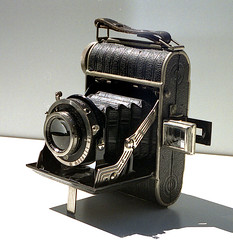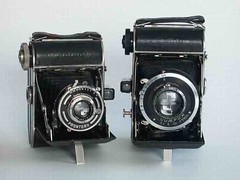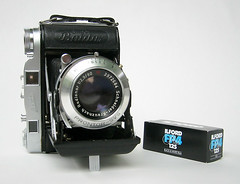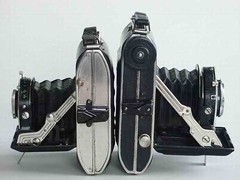Difference between revisions of "Baldax"
Rebollo fr (talk | contribs) m (link fix, entities, etc.) |
|||
| Line 9: | Line 9: | ||
|} | |} | ||
| − | The '''prewar Baldax''' was made throughout the 1930s in three main variants: a '''4. | + | The '''prewar Baldax''' was made throughout the 1930s in three main variants: a '''4.5×6 small model''' for #00 shutter size, a '''4.5×6 large model''' for #0 shutter size and a '''6×6 model''' (#0 size). All the Baldax had solidly built diagonal struts, with a typical shape, larger at the base. Some had a folding optical finder and others had a tubular optical finder. The body shape somewhat evolved during the production. |
| − | The Baldax was also sold under various distributor names, like the '''Lisette''' by [[Porst]], the '''Noris''' by Müller, the '''Ysette''' 4. | + | The Baldax was also sold under various distributor names, like the '''Lisette''' by [[Porst]], the '''Noris''' by Müller, the '''Ysette''' 4.5×6 and 6×6 by [[Rodenstock]] (equipped with Trinar lenses) or the '''Robra''' by Josef Rodenstock.<REF> {{MK}}, pp.799 and 848. </REF> It was also the basis of the [[Plaubel]] [[Roll-Op]] models, both in 4.5×6 and in 6×6 versions. |
{| class="plainlinks floatleft" style="text-align: center;" | {| class="plainlinks floatleft" style="text-align: center;" | ||
|- | |- | ||
| Line 18: | Line 18: | ||
|| ''Picture by mario_groleau. {{with permission}}'' | || ''Picture by mario_groleau. {{with permission}}'' | ||
|} | |} | ||
| − | In Japan it was copied by [[Proud]] for the [[Semi Proud]], which was in turn the basis of the [[Semi Olympus]], the first [[Olympus]] camera. Other Japanese copies of the Baldax were the | + | In Japan it was copied by [[Proud]] for the [[Semi Proud]], which was in turn the basis of the [[Semi Olympus]], the first [[Olympus]] camera. Other Japanese copies of the Baldax were the [[Heil]] and some of the [[Adler]] models sold by [[Ricoh|Riken]], the first [[Zeitax]] models, the [[Semi Lester]], [[Victor folders]] and [[Condor folders]] — the Victor Six and Condor Six are copies of the 6×6 version of the Baldax. |
| − | |||
{{br}} | {{br}} | ||
| Line 30: | Line 29: | ||
|} | |} | ||
| − | The '''postwar Baldax''' was an evolution of the prewar model, sold at the beginning of the 1950s by the West German company Balda Bünde. It existed in | + | The '''postwar Baldax''' was an evolution of the prewar model, sold at the beginning of the 1950s by the West German company Balda Bünde. It existed in 6×6 version and had a top housing incorporating the viewfinder and an exposure counter. At the same time, the '''Super Baldax''' was the same model with a coupled rangefinder. The [[Baldix|Baldix, Mess-Baldix and Baldi 29]] were derived from the postwar Baldax. |
{{br}} | {{br}} | ||
== Links == | == Links == | ||
Revision as of 23:34, 23 January 2009
The Baldax was a series of folding cameras made by the German company Balda.
Prewar models

|
| Robra, name variant of the prewar Baldax. Picture by junkyard_kahrs. (Image rights) |
The prewar Baldax was made throughout the 1930s in three main variants: a 4.5×6 small model for #00 shutter size, a 4.5×6 large model for #0 shutter size and a 6×6 model (#0 size). All the Baldax had solidly built diagonal struts, with a typical shape, larger at the base. Some had a folding optical finder and others had a tubular optical finder. The body shape somewhat evolved during the production.
The Baldax was also sold under various distributor names, like the Lisette by Porst, the Noris by Müller, the Ysette 4.5×6 and 6×6 by Rodenstock (equipped with Trinar lenses) or the Robra by Josef Rodenstock.[1] It was also the basis of the Plaubel Roll-Op models, both in 4.5×6 and in 6×6 versions.

|
| Picture by mario_groleau. (Image rights) |
In Japan it was copied by Proud for the Semi Proud, which was in turn the basis of the Semi Olympus, the first Olympus camera. Other Japanese copies of the Baldax were the Heil and some of the Adler models sold by Riken, the first Zeitax models, the Semi Lester, Victor folders and Condor folders — the Victor Six and Condor Six are copies of the 6×6 version of the Baldax.
Postwar models

|
| Super Baldax. Picture by Voxphoto. (Image rights) |
The postwar Baldax was an evolution of the prewar model, sold at the beginning of the 1950s by the West German company Balda Bünde. It existed in 6×6 version and had a top housing incorporating the viewfinder and an exposure counter. At the same time, the Super Baldax was the same model with a coupled rangefinder. The Baldix, Mess-Baldix and Baldi 29 were derived from the postwar Baldax.
Links

|

|
| Pictures by mario_groleau. (Image rights) |
In English:
- Super Baldax at Vintage Folding Cameras
- List of Balda instruction manuals at Orphancameras.com
In French:
In Japanese:
- Baldax at Puppy's Island, with sample pictures
- Baldax at Minosan's blog
- Baldax at Kume's camera site
Bibliography
- McKeown, James M. and Joan C. McKeown's Price Guide to Antique and Classic Cameras, 12th Edition, 2005-2006. USA, Centennial Photo Service, 2004. ISBN 0-931838-40-1 (hardcover). ISBN 0-931838-41-X (softcover).